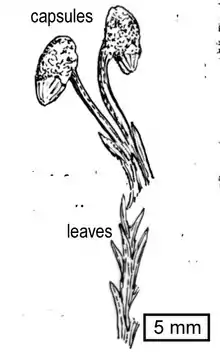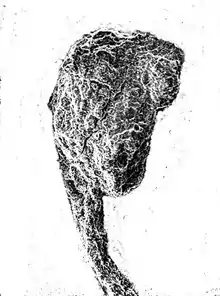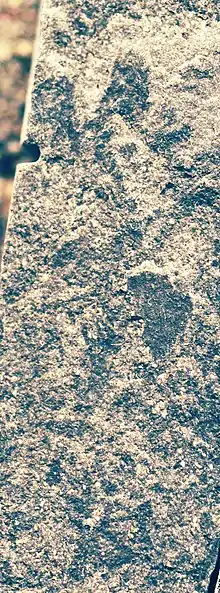Edwardsiphyton
Edwardsiphyton ("Edwards' plant") is a genus of fossil from the Middle Ordovician (Darriwilian, 460 million years old) Douglas Lake Member of the Lenoir Limestone from Douglas Dam Tennessee[1] The genus was named in honor of Dianne Edwards, and the epithet refers to the shape of the capsules.

Intepretative sketch of Edwardsiphyton ovatum

Capsule of Edwardsiphyton ovatum

Spore of Edwardsiphyton ovatum
| Edwardsiphyton Temporal range: | |
|---|---|
 | |
| A pair of recurveed capsules in apex of Edwardsiphyton ovatum, from Douglas Lake Member of Lenoir Limestone, at Douglas Dam, Tennessee[1] | |
| Scientific classification | |
| Kingdom: | Plantae |
| Division: | Bryophyta |
| Class: | Bryopsida |
| Subclass: | Dicranidae |
| Order: | Pottiales |
| Family: | Pottiaceae |
| Genus: | †Edwardsiphyton Retallack (2019) |
| Type species | |
| Edwardsiphyton ovatum Retallack (2019) | |
Description
Edwardisphyton was considered as moss fossil by Gregory Retallack. It has narrow acutely pointed leaves and recurved capsules. Spores are small and verrucate.
Biological affinities
Edwardsiphyton is similar to modern mosses of the family Pottiaceae such as Dicranum. The interpretation of this fossil as a harsh moss has been doubted in some quarters [2] but accepted in others.[3]
References
- Retallack, G.J. (2019). "Ordovician land plants and fungi from Douglas Dam, Tennessee". The Palaeobotanist. 68: 1–33.
- Edwards, Dianne; Morris, Jennifer L.; Axe, Lindsey; Duckett, Jeffrey G.; Pressel, Silvia; Kenrick, Paul (2022). "Piecing together the eophytes – a new group of ancient plants containing cryptospores". New Phytologist. 233 (3): 1440–1455. doi:10.1111/nph.17703. ISSN 0028-646X. PMID 34806774. S2CID 244495761.
- Leigh, Egbert (2022). "Fossil soils: trace fossils of ecosystems on land and windows on the context of evolution". Evolution Education and Outreach. 15:14: 1–5. doi:10.1186/s12052-022-00173-3. S2CID 252203727.
This article is issued from Wikipedia. The text is licensed under Creative Commons - Attribution - Sharealike. Additional terms may apply for the media files.